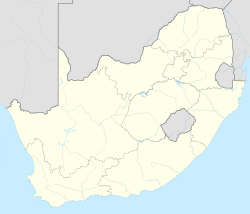Morokweng
| Morokweng | ||
|---|---|---|
|
|
||
| Coordinates | 26 ° 7 '36 " S , 23 ° 46' 30" E | |
| Basic data | ||
| Country | South Africa | |
| northwest | ||
| District | Dr Ruth Segomotsi Mompati | |
| ISO 3166-2 | ZA-NW | |
| local community | Kagisano-Molopo | |
| height | 1143 m | |
| surface | 24.2 km² | |
| Residents | 14,260 (2011) | |
| density | 590 Ew. / km² | |
| founding | 1790s | |
Morokweng is a place in the South African province of Northwest (North West). It is located in the Kagisano-Molopo parish in the Dr Ruth Segomotsi Mompati district .
geography
Morokweng has 14,260 inhabitants (2011 census). 93% of the population named Setswana as their first language in the census . The area is flat and sparsely populated, and the climate is arid . The Tswaing Pan salt pan is located near the village . Morokweng is about 60 kilometers northwest of Ganyesa . The place is south of the border with Botswana .
The southwestern Morokweng Crater , an impact crater discovered in 1994 and around 70 kilometers wide, is named after the place.
history
Morokweng emerged in the 1790s as the seat of Kgosi Manketso, who led a split from the Barolong . In 1886 the area around Morokweng and Ganyesa was declared as a native reserve after the formation of British Bechuanaland (for example: "Native reserve "). Until 1994 it belonged to the homeland Bophuthatswana .
Economy and Transport
The place is agriculturally oriented.
The R375 trunk road leads from the Botswana border in the northwest via Morokweng to Ganyesa in the southeast.
